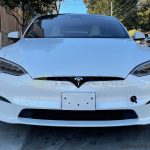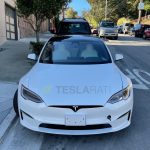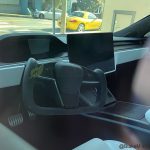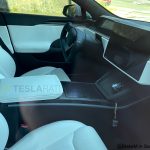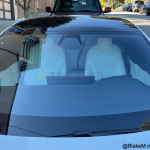
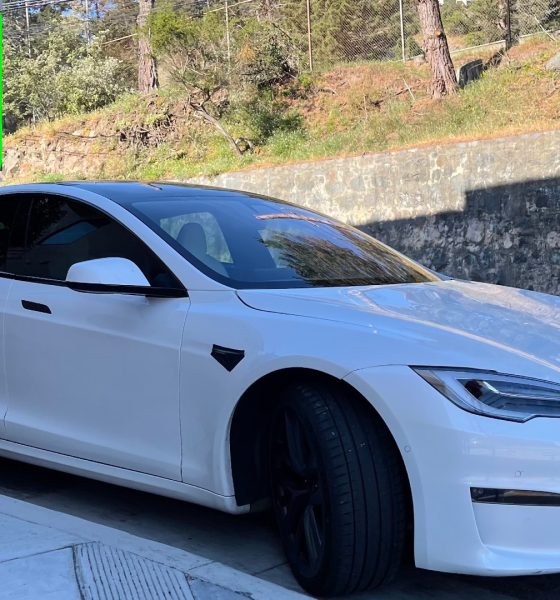
News
Tesla Model S Plaid photos shows clearest look at new interior to date
Recent photos of a Model S Plaid spotted parked in San Francisco streets reveal Tesla’s progress with its new flagship sedan.
Tesla owner @BlakeM in San Francisco shared a few Model S Plaid photos with Teslarati. The pictures give a clear image of the now-infamous Yoke steering wheel and the rear display at the back. He believes the Plaid Model S is a test mule because of the interior’s condition.
Some parts of the Model S were missing, supporting the idea that it was a test mule. There was a missing trim on the passenger side of the center console and a missing trim at the base of the “T” in the yoke steering wheel.
- Credit: Teslarati via @BlakeM in San Francisco
- Credit: Teslarati via @BlakeM in San Francisco
- Credit: Teslarati via @BlakeM in San Francisco
He noticed that a few diagnostic cables were hanging out of the center console of the Model S, where the phone would usually sit. The Tesla owner also observed that the pillar panel on the passenger’s side was partially removed, exposing cables. He believes the pillar panel was removed to gain access to the cables, or simply because the car might be a test mule.
BlakeM noted that the Model S had a “May” sticker next to the VIN at the back of the car, which might signify how recent the car was updated. According to the Model 3 Performance owner, a Model S Plaid has been spotted around his neighborhood for the past two months, so it might have been produced earlier this year. He observed no physical changes to the car over the past few months and believes any significant updates Tesla has made were with the car’s hardware or software.
- Credit: Teslarati via @BlakeM in San Francisco
- Credit: Teslarati via @BlakeM in San Francisco
- Credit: Teslarati via @BlakeM in San Francisco
- Credit: Teslarati via @BlakeM in San Francisco
The side cameras of the vehicle were covered with black gaffers tape, but the Tesla owner wasn’t certain if it was to cover the cameras or just camo. A tow hook can be seen at the front of the Model S Plaid as well.
Despite the missing trim pieces on the interior, the photos still provide a pretty good idea of what the new Model S’ interior would look like. The rear seats seem spacious enough, and the 8″ rear screen looks large enough to display media content adequately. The trim around the rear display may also help keep the screen from the occasional kick from kids sitting at the back.
- Credit: Teslarati via @BlakeM in San Francisco
- Credit: Teslarati via @BlakeM in San Francisco
- Credit: Teslarati via @BlakeM in San Francisco
- Credit: Teslarati via @BlakeM in San Francisco
A look at the front seats also hints at the ventilated seats of the new Model S. Coupled with Tesla’s already well-received seat design, the ventilated seats of the Model S Plaid would likely prove to be among the best seats in the market yet.
During the TSLA Q1 2021 earnings call, Elon Musk talked about the challenges Tesla faced when developing the new versions of the Model S and Model X. Tesla hopes to start Model S Plaid and Refresh deliveries soon. Musk clarified that deliveries depended on Tesla’s ability to ramp supply chain and internal production processes.
The Teslarati team would appreciate hearing from you. If you have any tips, email us at tips@teslarati.com or reach out to me at maria@teslarati.com.

Elon Musk
Elon Musk and Tesla AI Director share insights after empty driver seat Robotaxi rides
The executives’ unoccupied tests hint at the rapid progress of Tesla’s unsupervised Robotaxi efforts.

Tesla CEO Elon Musk and AI Director Ashok Elluswamy celebrated Christmas Eve by sharing personal experiences with Robotaxi vehicles that had no safety monitor or occupant in the driver’s seat. Musk described the system’s “perfect driving” around Austin, while Elluswamy posted video from the back seat, calling it “an amazing experience.”
The executives’ unoccupied tests hint at the rapid progress of Tesla’s unsupervised Robotaxi efforts.
Elon and Ashok’s firsthand Robotaxi insights
Prior to Musk and the Tesla AI Director’s posts, sightings of unmanned Teslas navigating public roads were widely shared on social media. One such vehicle was spotted in Austin, Texas, which Elon Musk acknowleged by stating that “Testing is underway with no occupants in the car.”
Based on his Christmas Eve post, Musk seemed to have tested an unmanned Tesla himself. “A Tesla with no safety monitor in the car and me sitting in the passenger seat took me all around Austin on Sunday with perfect driving,” Musk wrote in his post.
Elluswamy responded with a 2-minute video showing himself in the rear of an unmanned Tesla. The video featured the vehicle’s empty front seats, as well as its smooth handling through real-world traffic. He captioned his video with the words, “It’s an amazing experience!”
Towards Unsupervised operations
During an xAI Hackathon earlier this month, Elon Musk mentioned that Tesla owed be removing Safety Monitors from its Robotaxis in Austin in just three weeks. “Unsupervised is pretty much solved at this point. So there will be Tesla Robotaxis operating in Austin with no one in them. Not even anyone in the passenger seat in about three weeks,” he said. Musk echoed similar estimates at the 2025 Annual Shareholder Meeting and the Q3 2025 earnings call.
Considering the insights that were posted Musk and Elluswamy, it does appear that Tesla is working hard towards operating its Robotaxis with no safety monitors. This is quite impressive considering that the service was launched just earlier this year.
Elon Musk
Starlink passes 9 million active customers just weeks after hitting 8 million
The milestone highlights the accelerating growth of Starlink, which has now been adding over 20,000 new users per day.

SpaceX’s Starlink satellite internet service has continued its rapid global expansion, surpassing 9 million active customers just weeks after crossing the 8 million mark.
The milestone highlights the accelerating growth of Starlink, which has now been adding over 20,000 new users per day.
9 million customers
In a post on X, SpaceX stated that Starlink now serves over 9 million active users across 155 countries, territories, and markets. The company reached 8 million customers in early November, meaning it added roughly 1 million subscribers in under seven weeks, or about 21,275 new users on average per day.
“Starlink is connecting more than 9M active customers with high-speed internet across 155 countries, territories, and many other markets,” Starlink wrote in a post on its official X account. SpaceX President Gwynne Shotwell also celebrated the milestone on X. “A huge thank you to all of our customers and congrats to the Starlink team for such an incredible product,” she wrote.
That growth rate reflects both rising demand for broadband in underserved regions and Starlink’s expanding satellite constellation, which now includes more than 9,000 low-Earth-orbit satellites designed to deliver high-speed, low-latency internet worldwide.
Starlink’s momentum
Starlink’s momentum has been building up. SpaceX reported 4.6 million Starlink customers in December 2024, followed by 7 million by August 2025, and 8 million customers in November. Independent data also suggests Starlink usage is rising sharply, with Cloudflare reporting that global web traffic from Starlink users more than doubled in 2025, as noted in an Insider report.
Starlink’s momentum is increasingly tied to SpaceX’s broader financial outlook. Elon Musk has said the satellite network is “by far” the company’s largest revenue driver, and reports suggest SpaceX may be positioning itself for an initial public offering as soon as next year, with valuations estimated as high as $1.5 trillion. Musk has also suggested in the past that Starlink could have its own IPO in the future.
News
NVIDIA Director of Robotics: Tesla FSD v14 is the first AI to pass the “Physical Turing Test”
After testing FSD v14, Fan stated that his experience with FSD felt magical at first, but it soon started to feel like a routine.

NVIDIA Director of Robotics Jim Fan has praised Tesla’s Full Self-Driving (Supervised) v14 as the first AI to pass what he described as a “Physical Turing Test.”
After testing FSD v14, Fan stated that his experience with FSD felt magical at first, but it soon started to feel like a routine. And just like smartphones today, removing it now would “actively hurt.”
Jim Fan’s hands-on FSD v14 impressions
Fan, a leading researcher in embodied AI who is currently solving Physical AI at NVIDIA and spearheading the company’s Project GR00T initiative, noted that he actually was late to the Tesla game. He was, however, one of the first to try out FSD v14.
“I was very late to own a Tesla but among the earliest to try out FSD v14. It’s perhaps the first time I experience an AI that passes the Physical Turing Test: after a long day at work, you press a button, lay back, and couldn’t tell if a neural net or a human drove you home,” Fan wrote in a post on X.
Fan added: “Despite knowing exactly how robot learning works, I still find it magical watching the steering wheel turn by itself. First it feels surreal, next it becomes routine. Then, like the smartphone, taking it away actively hurts. This is how humanity gets rewired and glued to god-like technologies.”
The Physical Turing Test
The original Turing Test was conceived by Alan Turing in 1950, and it was aimed at determining if a machine could exhibit behavior that is equivalent to or indistinguishable from a human. By focusing on text-based conversations, the original Turing Test set a high bar for natural language processing and machine learning.
This test has been passed by today’s large language models. However, the capability to converse in a humanlike manner is a completely different challenge from performing real-world problem-solving or physical interactions. Thus, Fan introduced the Physical Turing Test, which challenges AI systems to demonstrate intelligence through physical actions.
Based on Fan’s comments, Tesla has demonstrated these intelligent physical actions with FSD v14. Elon Musk agreed with the NVIDIA executive, stating in a post on X that with FSD v14, “you can sense the sentience maturing.” Musk also praised Tesla AI, calling it the best “real-world AI” today.
